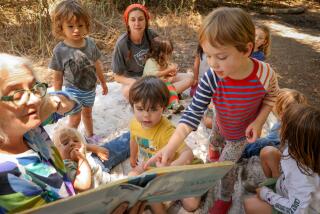BUENA PARK : Reptiles Slither Into Curriculum
- Share via
Yasmeen Yassa likes snakes. Her favorite is a ball python that lives in a terrarium in her classroom.
“He’s the kindest snake,” said Yasmeen, 6, a first-grader at Gordon H. Beatty School. “And I learned that he has a pink tongue.”
Inside Diana West’s classroom, Yasmeen and fellow students are introduced to the world of reptiles and other animals. The classroom menagerie includes snakes, turtles, lizards, fish and what West and her students call a “Pac-Man” frog, a “candy crab” and a “pink-toed” tarantula.
They are not pets but specimens used to teach the youngsters lessons in science, reading, writing and arithmetic.
So instead of just reading about water dragon lizards, leopard gecko lizards, red-eared slider turtles or milk snakes in textbooks and seeing pictures of them, West has designed a curriculum that allows students to see and touch them.
West developed a reptile curriculum for second-graders attending schools in Buena Park School District. But it also can be tailored for first- and third-graders.
West, who has been a teacher 23 years, said she has had animals in her classroom for at least the past six years.
“It was something I felt I was ready to do,” said West of developing the reptile curriculum. “It was an interest I thought others would benefit from too.”
What makes her curriculum unique is that each classroom at the elementary school has a reptile-in-residence--either a snake, a turtle or lizard.
The reptile theme is used to teach subjects such as math, spelling or writing, and these are done in a cooperative or group setting, which West says also serves to teach social skills.
“Because of the interest by children in live animals, I thought it would be a good springboard to do cooperative learning because you can bring in all curriculum areas,” West said.
For instance, math skills are taught when children must estimate a snake’s length; writing skills are used when children are asked to describe the reptiles they learn about.
Why reptiles? West said she chose them because they are low-maintenance animals that are quiet, don’t smell and live a relatively long time.
The only problem is that they require live food such as mice, goldfish or crickets.
Barbara Economou, who also teaches the reptile curriculum to her students, has seven turtles at home. Naturally, she chose a turtle to keep in her classroom.
“I would never have a snake in my classroom,” she said.
Economou agreed that using live reptiles heightens students’ learning.
“Having the actual animal there makes more of an impression to the kids than pictures,” she said. “They’re learning more when they can feel and touch and observe with their own eyes.”
West’s students say reptiles are a fun way to learn.
Sherien Sobhy, 6, said she likes to touch them, especially the ball python, “because I know it won’t hurt me.”
Eric Clarke, 7, said his favorite is the Tokay gecko lizard. “I like this one because he has yellow eyes and red spots on him,” he said, peering at the creature’s head as it hid under a log in the terrarium.
Eric said he has learned a lot about snakes and likes to touch their scales, adding: “It’s neat to see them slither.”
Being in West’s classroom is definitely a special experience, say her students.
“It’s really a great place in (Room) A-2,” Yasmeen said.
More to Read
Sign up for Essential California
The most important California stories and recommendations in your inbox every morning.
You may occasionally receive promotional content from the Los Angeles Times.













![Vista, California-Apri 2, 2025-Hours after undergoing dental surgery a 9-year-old girl was found unresponsive in her home, officials are investigating what caused her death. On March 18, Silvanna Moreno was placed under anesthesia for a dental surgery at Dreamtime Dentistry, a dental facility that "strive[s] to be the premier office for sedation dentistry in Vitsa, CA. (Google Maps)](https://ca-times.brightspotcdn.com/dims4/default/07a58b2/2147483647/strip/true/crop/2016x1344+29+0/resize/840x560!/quality/75/?url=https%3A%2F%2Fcalifornia-times-brightspot.s3.amazonaws.com%2F78%2Ffd%2F9bbf9b62489fa209f9c67df2e472%2Fla-me-dreamtime-dentist-01.jpg)